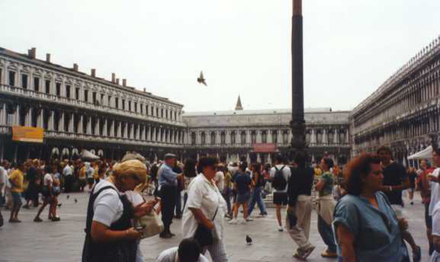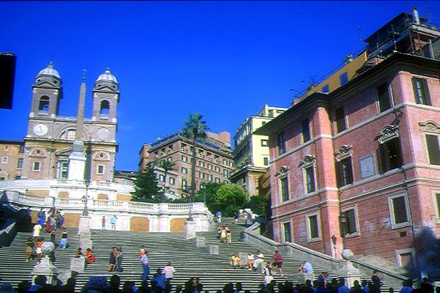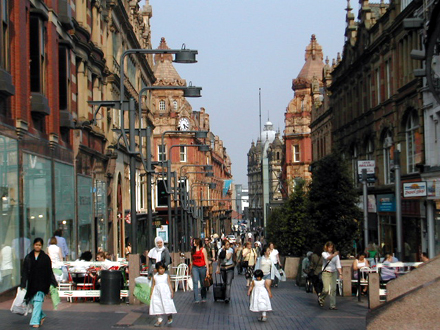If we cannot become a real community we can never again be a proper town.
By Ben Bull
Published June 16, 2005
(This is Part II of a two-part series. Read Part I)
As I toured the bright open spaces and darkest corners of some of Europe's finest cities I learned one thing quickly: there were always surprises.
One night, as I was strolling along the ancient walls of the Alhambra in Granada, I heard a strange murmuring sound below, like a giant wasps' nest ro the distant rumble of a thunderstorm. It was entirely new to me.
After walking along the wall a little bit, looking for the source, I looked down, and there it was. About 100 feet below sprawled an old city enclave of simple stone buildings scattered around the landscape like a child's discarded building blocks.
The roads - such as they were - were dirt and gravel and barely wide enough for one car to pass. This didn't matter because one thing was plain to see: these streets belonged to the people.
Everywhere and all around were the sights and sounds of running children, boisterous adults and abandoned pets; singing, shouting, barking and swearing. All the sounds mingled together and climbed the walls to pronounce a single word: life.

St. Mark's Square, Venice
In Venice I witnessed beauty and life on a different scale. As I turned the corner and took in the view of St Mark's Square I had the unusual emotion of being speechless. Here, in front of the Clock Tower, Doges Palace and 15th century Basilica, time had stood still.
And why not? I thought. How could we ever have improved on this?
Sitting in the Square with Mark, my traveling companion, I enjoyed the longest coffee break of my life. There was no conversation, just the sense that in a place like this, no words were needed.
It occurred to me as I looked around that this Square was so much more enjoyable because of the sense of history it aroused. It was as if the ancient buildings were imposing a silent but shared experience, a common bond, that took a bunch of disparate people - rich locals, poor locals, backpackers and tourists - and gave us all an impenetrable sense of togetherness.
Some commonalities Ben noted in public spaces:
Reasons to be there - lots to do, mixed uses: retail (marketplaces), tourist spots, work, residential
Accessibility - public transit is key
Pedestrian friendly - few cars, easy and safe to walk around
Things to see - free entertainment, people watching, street vendors, festivals, street performers
Something for everyone - diversity; need to attract a diverse range of citizenry
Attractive and clean
Safe, well lit
Linked to history of town - need to feature historical architecture, statues, every square should 'tell a story'
Low overhead - easy to maintain, simple design
Belongs to the people - should be a public space, not privately owned
Outdoors - open to the elements
Lots of places to sit and congregate
The next night, we found ourselves in nearby Padua where we stopped to get some tickets for a Madonna concert in Turin. Unable to find a place to stay we opted for that old backpacker's standby: the park.
As night drew close we found that our little collection of park benches was also the resting place for Padua's down-and-outs. As we laid out our sleeping bags we watched these poor bedraggled citizens stretch out beside us and take silent comfort in each other's company. It seemed clear to me then, that one thing we humans need more than anything is to be together.
Two days later, we found ourselves together with a much different crowd. Packed into the Stadio Communale in Turin we sweated, swayed and sang, along with 20,000 Madonna/Juventus fans as we waited for the Material Girl to hit the stage. We were quickly picked out as the "the enemy" (perhaps it was the England football strip?) and "encouraged" to join them in their pre-concert warm up - singing soccer songs.
After a two minute rehearsal, enjoyed enormously by the throng of people circled around us, we joined in a spirited rendition of the single-lyric Italian soccer anthem "Ole, Ole, Ole, Ole!" and became the unofficial members of yet another world community.
Rome's Spanish Steps were an all-too-fleeting experience, overshadowed by the embarrassing antics of our wacky companion and self-proclaimed "tour guide". Somehow - and to this day I can't remember how - Mark and I had managed to pick up some middle-aged German bloke called Fritz who insisted on showing us around Rome.
Fritz's sightseeing tour was like nothing I had ever seen in any travel agency. Our first stop was a strip of grass on the outskirts of town. "What the hell is this?" I remember asking as we stepped off the bus in the middle of nowhere.

Spanish Steps in Rome
"Come and meet my friends!" replied Fritz, pushing us along.
Fritz's "friends" were all sitting around on the strip of grass and looking in every way like they were America's Most Wanted (well, Italy's, anyway).
My impressions were confirmed when Fritz announced excitedly, "This is where we come when we get out of prison!"
"Erm ... prison?" muttered Mark nervously.
"What do you mean 'we'?" said I, even more nervously.
"Where the hell are we?" whispered Mark, trying not to panic.
This was Convicts Park, the unofficial name for one of Rome's lesser known people places. And, as Fritz politely introduced us to the many members of his ex-con fraternity, it occurred to me that Europe really does have an unusual abundance of these people places.
Over the next two days we endured the unfailing enthusiasm of our overly eager ex-Con tour guide with a naivety and good grace that we would quickly come to regret. We gleefully ran the gauntlet of obligatory Roman hot spots until at last we reached the Spanish Steps.
It was here, among the soothing music of the local buskers and the beauty of the Trevvi fountain that we decided to carry out our cunning escape plan ("When he's not looking - run!").
But it was not to be. As we threw our coins into the fountain and took in the spontaneity and excitement of another people place to remember, we began to feel a wonderful sense of warmth towards our fellow human beings - even Fritz. So we gave him another chance.
We were rewarded the next morning with an unusually large hotel bill, half of which belonged to Fritz, who had buggered off. Of course we knew where we might find him but we figured it was probably best to just move along.
Misunderstanding: they are a waste of taxpayer's money. Reality: they encourage street life and therefore commerce and tourism.
Misunderstanding: they are unsafe, they encourage teenage gatherings and crime. Reality: empty streets are the most dangerous. People are safer in numbers.
Misunderstanding: they are dirty and unpleasant. Reality: they reflect the pride and population of their town.
Misunderstanding: they are usually deserted. Reality: if located in areas of mixed use, there will always be people around.
Misunderstanding: they are a luxury for a town, they are not necessary. Reality: They are not an essential ingredient for a successful downtown, but they can significantly enhance the pride and identity of the population, and can themselves serve as a destination point.
My trip with Mark ended a few towns later, but I wanted more. I set off again two years later, heading this time towards Cairo with a quirky Norwegian fellow called Arno. For some reason, the two of us had come to the conclusion that everyone in Egypt wore flowing robes and headscarves. And so, not wishing to look odd, we decided to dress the part.
Of course, on arriving in town we found ourselves the victims of one of those improbable Bridget Jones' Diary fancy dress moments where everyone else walks around looking normal and we are, well, dressed like idiots.
As we strode around town looking for a place to stay we had the unfortunate impact of actually stopping traffic and generally causing a scene wherever we went. After ducking into the nearest hotel for a change of clothes we found, to our amusement, that we were still getting mobbed. I'm convinced it was Arno's bright blonde hair that did it, but eventually we began to enjoy out little bit of infamy.
At one point one of the locals decided I must be Bono from U2 and I had a wonderful time trying out my flawless Irish accent to the delight of our ever-expanding entourage. I wondered who they thought Arno might be - Rod Stewart?
More importantly, we got to see the heart and soul of this remarkable city through the simple effort of just walking around. Cairo, like Venice, is a people place. Although it is infested with trucks and cars and, yes, the people really do hang off the sides of buses, it is a town with people at its core.
The locals were everywhere, milling around and minding everybody's business but their own. It felt like we were in the middle of a Where's Waldo? montage featuring an improbable amount of unrelated activities that somehow seemed to link together to form an ever-evolving city scene.
Vendors stood around tending to their shops and stalls, people walked about aimlessly and in a hurry, and every doorway was propped up by old men sipping coffee and smoking hookahs.
The next day I walked out onto the 21st floor hotel balcony, threw up (I knew that cous cous smelled funny), and looked around to see the city exactly the way I left it - chaotic. As I peered into the distance and made out the shimmering shapes of the Great Pyramids I realized that a city does not have to be clean, efficient and car-free to be cool. It just has to be alive. The one thing that makes a city live and breathe is its people.
Back in Leeds, my home at that time, I marveled at how un-European my native country really was. I felt that the people places of Leeds paled in comparison to their European cousins. How I longed for a stroll down Las Ramblas or a cuppa in St Anthony's Square!

Street life in Leeds
But as Leeds, itself a city working to turn itself around, began to prosper, the locals began to walk the streets once again and new people places began to appear.
I took my Spanish Mother-in-Law, Maria, to the newly renovated Corn Exchange and was delighted to find the beginnings of a café culture taking shape under the 19th Century domed roof. Perhaps Maria gained some appreciation of the challenges my changing town faced, as European nuances, like tipping, were met with outright confusion by the local waitresses (Hey love! You forgot your change...").
My four years in Toronto helped me appreciate just what a cultural barrier North Americans appear to have towards this "people first" culture. Toronto, while it does so much so well - the Beaches, High Park and the hot spots along College, Spadina and Queen to name but a few - also seems to struggle to embrace and build upon what it already has.
The underground PATH network in the heart of the downtown Financial district creates an empty and anemic outdoor environment in what should be the most vibrant quarter of the 9-5 day. The towering waterfront condos that continue to block the view have somehow sucked the life from the water's edge.
And then there's Dundas Square, where our story began, and which is better known as a place to get through or get around, rather than a place to sit and stay.
Finally, there's Hamilton, where the word "potential" seems destined to be forever used but never realized.
I wonder if we, in Hamilton, "get it"? Our Bayfront Park and Pier redevelopment appears to underline the importance of that key ingredient, the slow-to-arrive waterfront cafes are a cause for concern, as is the frequent mention of "Waterfront condos" and "more industry."
Similarly, all this talk of pedestrianization along King Street south, in Gore Park, is promising enough. But its deeds that count, not words. We shall see.
For now I am left to reflect on my own experiences and hope that Hamilton really can come to life so that we can all know what it's like to live, work and play together. Because, as our road rage, mall shopping and backyard barbeque way of life has shown - if we cannot get together, we cannot become a real community. If we cannot become a real community we can never again be a proper town.
I sincerely hope to see you all soon, milling around doing nothing in a people place near you. I'll be the bloke sat on the bench sipping his coffee, smiling - and doing nothing at all.
You must be logged in to comment.
There are no upcoming events right now.
Why not post one?